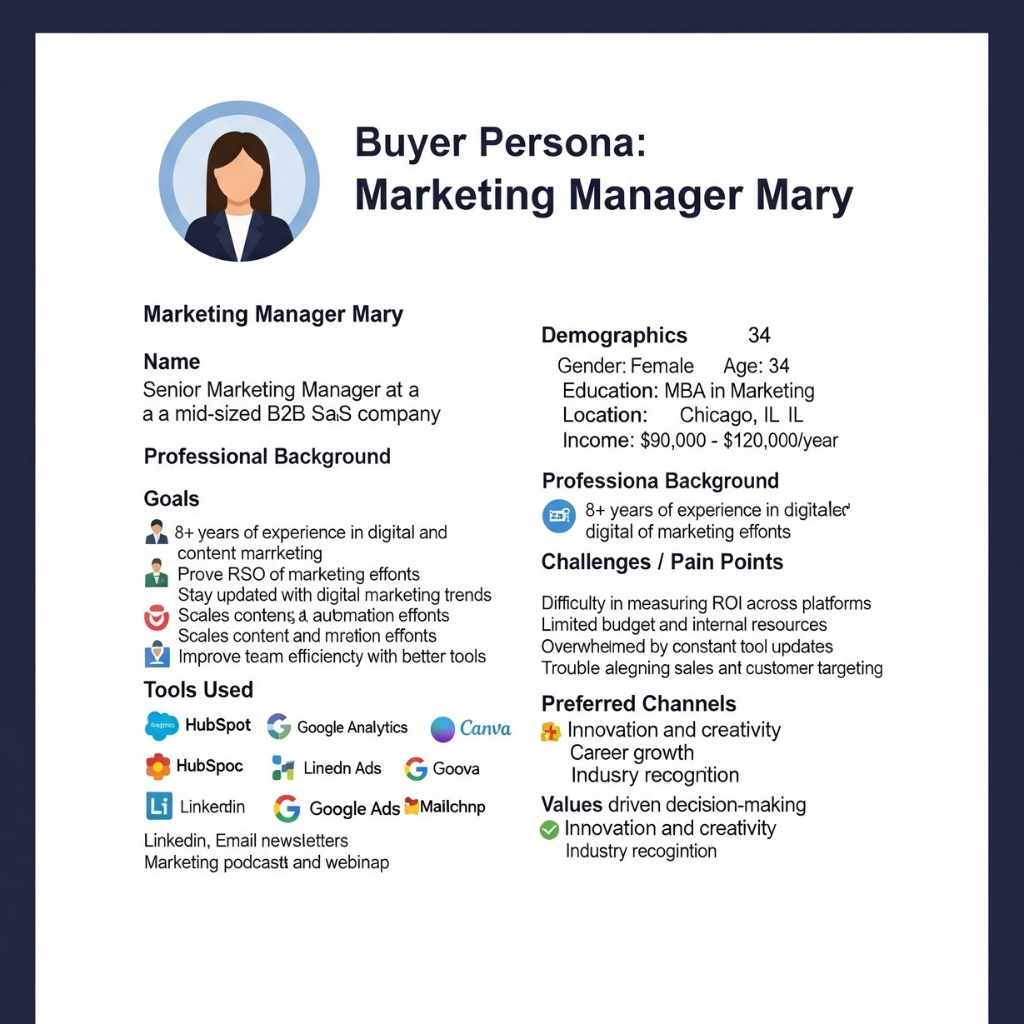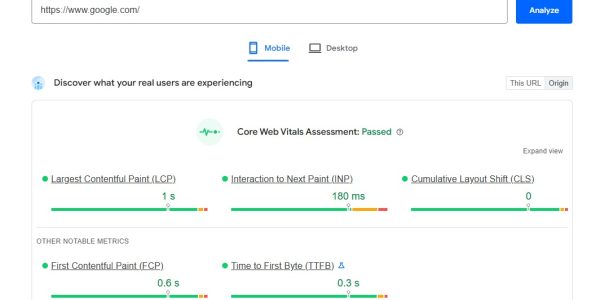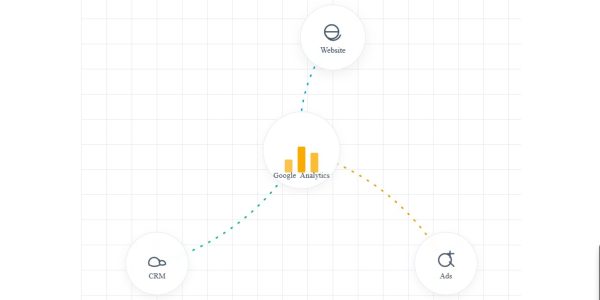You’ve spent weeks crafting the perfect social media campaign. The copy is witty, the visuals are stunning, and you hit “publish” with a surge of confidence. Then… crickets. A few pity likes from your colleagues, maybe one or two comments from bots, but zero real engagement from the people you actually want to reach.
Sound familiar? This frustrating scenario is the direct result of a common marketing blind spot: broadcasting a message without truly knowing who you’re talking to.
The solution isn’t a bigger budget or flashier graphics. It’s about going deeper. It’s about creating effective buyer personas—detailed, semi-fictional representations of your ideal customers. This guide will walk you through a proven, data-backed process to build personas that will transform your social media strategy from a shot in the dark to a precision-guided missile.

What Exactly is a Buyer Persona (And Why Does It Matter for Social Media)?
A buyer persona (sometimes called a customer persona or marketing persona) is a detailed profile of a target customer. It’s not just a collection of demographic data like age and location. A powerful persona brings your ideal customer to life with a name, a job title, goals, challenges, and motivations.
Think of it this way: you wouldn’t give the same birthday gift to your tech-obsessed nephew and your garden-loving grandmother. You tailor the gift because you know them. Why should your marketing be any different?
For social media marketing, personas are non-negotiable. They are the bedrock of a successful strategy, influencing:
- Content Creation: You’ll know exactly what topics, formats (video, text, infographics), and tones will resonate with your audience.
- Ad Targeting: You can create highly specific audiences on platforms like Facebook, LinkedIn, and Instagram, dramatically lowering your ad spend and increasing conversion rates.
- Platform Choice: You’ll know whether your ideal customer spends their time scrolling through LinkedIn feeds or watching TikTok tutorials, so you can focus your efforts where they’ll have the most impact.
- Community Engagement: You’ll understand how to talk to your audience, what questions to ask, and how to build a genuine community around your brand.
The Foundational Flaw: Guesswork vs. Data-Driven Personas
Here’s where most businesses go wrong. They gather their team in a room and invent a persona based on assumptions. “Oh, our customer is probably a 35-year-old manager named Mark who likes golf.”
This is a persona built on guesswork, and it’s practically useless.
Effective personas are not works of fiction; they are composites built from real-world data. At Infineural Technologies, we believe that every successful marketing decision is rooted in data. When you skip the research, you’re building your entire strategy on a foundation of sand. The secret to creating effective buyer personas is to trade your assumptions for analytics.
Your 5-Step Guide to Creating Effective Buyer Personas
Ready to stop guessing and start connecting? Follow this five-step framework to build detailed, actionable buyer personas that deliver real results.
Step 1: Conduct Thorough Audience Research
This is the most critical step. Your goal is to gather as much quantitative and qualitative data as possible about your current and desired customers. Don’t limit yourself to one source; triangulate your findings from multiple channels.
Where to Find Your Data:
- Your Website Analytics: Dive into Google Analytics. Look at the Audience reports to find data on age, gender, location, and interests. Analyze which content on your site gets the most traffic.
- Social Media Analytics: Every platform has a native analytics tool (Facebook Audience Insights, LinkedIn Analytics, etc.). Use them to see who follows you, who engages with your content, and their demographic makeup.
- Your CRM and Sales Data: Your Customer Relationship Management software is a goldmine. Talk to your sales team—they are on the front lines talking to customers every day. Ask them about common questions, pain points, and success stories. How to Align Your Sales and Marketing Teams
- Customer Surveys and Interviews: This is the best way to get qualitative data. Send a survey to your email list or conduct short interviews with your best customers. Ask open-ended questions like:
- What is your biggest challenge at work right now?
- What social media platforms do you use daily?
- Where do you go for information to help you do your job better? (e.g., blogs, podcasts, industry leaders)
- What made you choose our product/service over a competitor?
Step 2: Identify Customer Pain Points and Goals
Data is just numbers and words until you interpret it. The next step is to sift through your research and identify recurring patterns. What are the common threads?
Group your findings into two key categories:
- Goals: What is this person trying to achieve? What does success look like for them, both personally and professionally?
- Example: “I want to prove the ROI of our social media efforts to my boss.”
- Pain Points (Challenges): What obstacles are standing in their way? What keeps them up at night?
- Example: “I don’t have enough time to create high-quality content for all our social channels.”
This step is where empathy comes in. You need to put yourself in their shoes. Understanding their struggles is the key to positioning your product or service as the solution they’ve been searching for. According to a HubSpot study, mapping the customer journey and understanding pain points can significantly improve marketing effectiveness.
Step 3: Segment Your Audience and Prioritize Personas
As you analyze your data, you’ll likely notice a few distinct groups emerging. You might have a “Startup Founder Sam” who is budget-conscious and needs quick results, and an “Enterprise Marketing Director Diana” who is focused on brand safety and long-term strategy.
It’s tempting to create a dozen different personas, but this can lead to paralysis. Start by defining one to three core personas. If you’re just beginning, focus on creating a single, primary persona that represents the most crucial segment of your audience. You can always build more later. Ask yourself: “Which type of customer brings the most value to our business?” Start there.
Step 4: Humanize Your Persona with a Story
Now it’s time to bring your data-driven persona to life. This is where you transform your spreadsheets and survey results into a relatable character that your entire team can understand and rally behind.
Grab a template and fill it out. Give your persona a name and a stock photo to make them feel real.
Your Buyer Persona Template Should Include:
- Name & Photo: e.g., “Marketing Manager Mary”
- Background: Job title, industry, career path, family life.
- Demographics: Age, gender, income, location.
- Goals: A list of their primary and secondary objectives.
- Challenges: The key pain points you identified in Step 2.
- Communication Preferences: How do they like to be contacted? What social media do they use?
- Quotes: A real quote from an interview or a representative summary. e.g., “I need a way to manage all our social accounts without losing my mind.”
- How We Help: A clear statement on how your company solves their specific problems.

Step 5: Integrate and Refine Your Personas
A buyer persona is not a document that you create once and file away. It’s a living tool that should guide your daily marketing decisions.
- Share it: Make sure everyone on your marketing, sales, and even product development teams has a copy. When someone asks, “Should we post this on LinkedIn?” the answer should be, “Well, would Marketing Manager Mary find it useful?”
- Apply it: Use your persona to brainstorm blog topics, write ad copy, choose social media imagery, and define your brand voice.
- Update it: Markets change, and so do people. Set a reminder to revisit and update your personas at least once a year, or whenever you get significant new customer insights.
How Infineural Technologies Leverages Personas for Social Media Success
Theory is great, but application is what drives results. At Infineural Technologies, the process of creating effective buyer personas is the first step in every client engagement. We don’t just build personas; we operationalize them to create hyper-targeted social media strategies that work.
For example, when working with a B2B SaaS client, our research revealed their primary persona wasn’t the C-suite executive they assumed, but a mid-level IT Manager overwhelmed by integrating new software.
Armed with this insight, we completely shifted their social media strategy:
- Content: We moved away from high-level “thought leadership” and created practical, how-to guides and short video tutorials addressing the IT Manager’s integration pains.
- Platform: We deprioritized Facebook and doubled down on LinkedIn and niche tech forums where this persona sought advice.
- Advertising: Our ad creative and copy spoke directly to their challenges, with CTAs offering a “free integration checklist” instead of a generic “request a demo.”
The result? A 40% decrease in cost-per-lead and a 200% increase in qualified leads in just one quarter. This is the power of a data-driven persona in action. Our services help you uncover these insights and turn them into a winning strategy.
Common Pitfalls to Avoid When Building Your Buyer Personas
As you embark on this process, watch out for these common mistakes:
- Creating Too Many Personas: Start with one or two. Quality over quantity.
- Focusing Only on Demographics: Age and location are just the beginning. Motivations and pain points are what truly matter.
- Forgetting the “Negative Persona”: It’s often just as important to know who you don’t want as a customer (e.g., those who are too expensive to acquire, have a high churn rate, or are not a good fit for your product).
- Keeping Them a Secret: A persona is useless if it’s not shared and used by your entire customer-facing organization.
From Persona to Profit: Your Next Step
Stop shouting into the void. Creating effective buyer personas is the most powerful investment you can make in your social media marketing. It’s the difference between creating content that gets ignored and crafting messages that resonate, engage, and convert.
By following this data-driven framework, you can gain a profound understanding of your ideal customer and build a strategy that speaks directly to their needs. You’ll not only see your social media metrics improve, but you’ll also build a more loyal customer base and a stronger brand.
Ready to stop guessing and build a social media strategy that drives real business growth?The team at Infineural Technologies are experts at uncovering audience insights and turning them into powerful marketing campaigns.
Schedule a free, no-obligation strategy call with one of our experts today!


